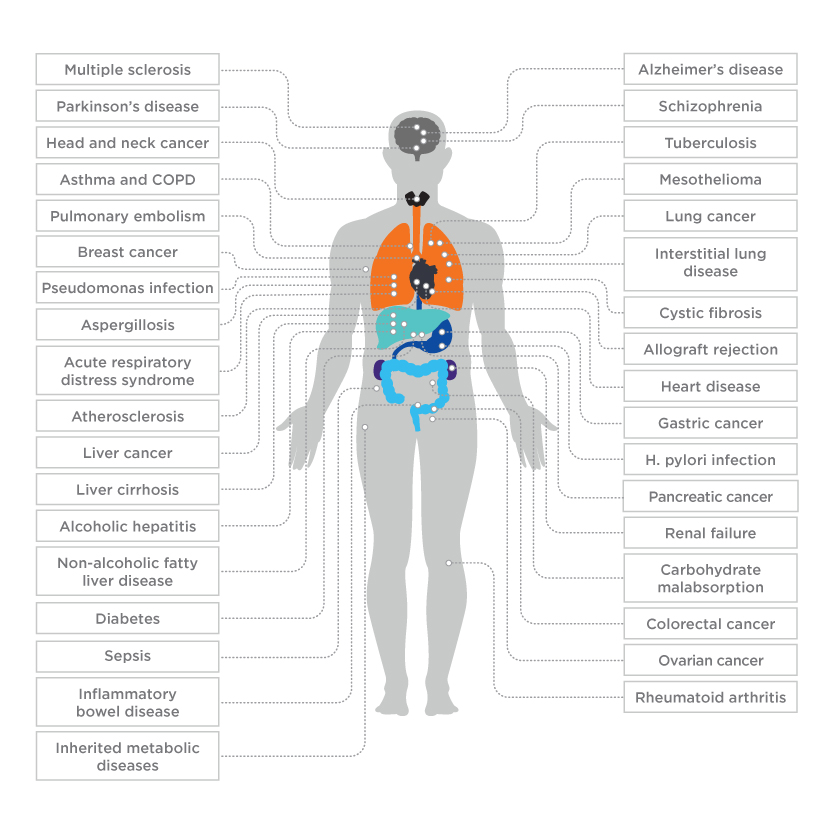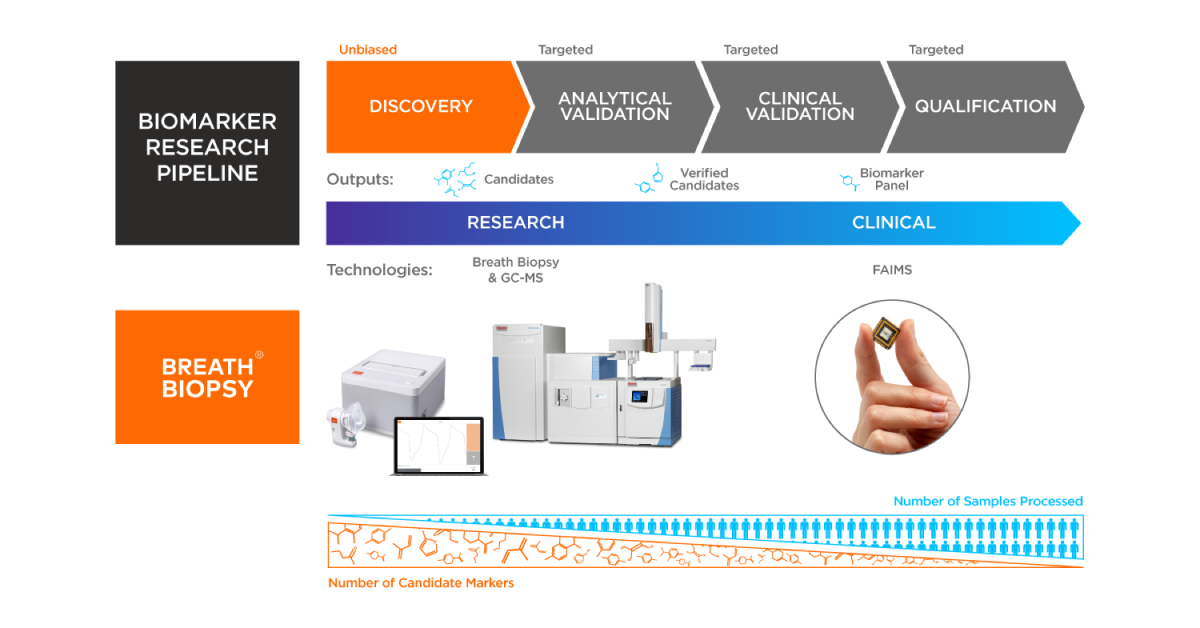What is Breath Biopsy useful for?
Published on: 23 Jan 2023, under Breath Biopsy
Human breath is a rich and largely untapped source of biological information, capable of revealing general insights into a subjects’ overall health as well as specific indicators of disease onset and progression. Exhaled breath is also an inexhaustible resource that can be collected simply and non-invasively.
While a few breath tests are already in clinical use, many studies have demonstrated the potential to develop novel tests based on breath biomarkers, for early detection, precision medicine and treatment monitoring. These studies cover a wide range of different disease areas, including respiratory diseases, cardiovascular and metabolic diseases, gut health, neurological diseases, infectious diseases and cancer.
Much of the ongoing research in breath focuses on volatile organic compounds (VOCs) which are delivered to the lung via systemic circulation from all over the body and detectable on breath. VOCs are often products of endogenous biochemistry, of human metabolic processes and also metabolism within our microbiome, so can report on metabolic changes within the body. With sufficient biological understanding underpinning them, breath tests can therefore target specific metabolic pathways.
Where is breath testing already in clinical use?
In gastroenterology
A number of gastrointestinal (GI) conditions are characterized by excessive fermentation in the gut microbiota. This fermentation of carbohydrates by the gut microbiome leads to production of gases, and other metabolites. Hydrogen and methane gas are both produced as part of this process by our microbiome but are not products of human metabolism – giving them utility as biomarkers of bacterial fermentation.
Hydrogen and methane breath tests (HMBTs) have been widely adopted in clinical practice for the diagnosis of small intestinal bacterial overgrowth (SIBO), with alternative diagnostics (like jejunal aspirate) comparatively invasive and expensive. A diagnosis of SIBO is determined by rising hydrogen after consumption of carbohydrates but the same test can be used to diagnose intestinal methanogen overgrowth (IMO), on the basis of rising methane levels, or malabsorption of specific carbohydrates, such as a glucose or lactulose intolerance.
Breath tests that measure urea on breath to diagnose Helicobacter pylori infections are also well established in the clinic.
In respiratory disease
Nitric oxide (NO) on breath is considered a measure of inflammation within the airways. Detection of nitric oxide (NO) is widely assessed as part of the diagnosis of chronic inflammatory airway diseases, with this test most strongly associate with asthma. Patients with asthma have higher levels of exhaled NO than controls and NO levels correlate well with other clinical markers of asthma.
Where are the next clinical breath tests coming from?
While breath has established clinical uses in respiratory disease and GI disease, the fact that breath VOCs can originate all over the body gives breath tests the potential to report on extremely varied diseases.
Indeed, breath biomarkers have been investigated in relation to many different conditions, some of which are shown below in Figure 1, and there are numerous opportunities still to be explored. However, there are a number of the areas where novel breath tests are especially close to reaching the clinic.

In cardiovascular and metabolic disease
Many studies have investigated the utility of breath biomarkers for the diagnosis and monitoring of cardiovascular and metabolic diseases (CVMD), such as diabetes, kidney disease, heart failure and strokes, but the greatest progress has been made in the area of liver disease.
Across a number of studies, including our own, limonene, a terpene abundant in citrus fruit, has been found to be elevated on the breath of those with liver cirrhosis. This is attributable to dietary limonene being less easily metabolized as liver function reduces. Breath limonene correlates well with both disease severity and established blood biomarkers of liver function.
We’ve recently conducted additional in vivo and in vitro studies to validate limonene’s performance and identify additional VOCs that can support the development of a clinical breath test for liver disease. Our best performing diagnostic model currently includes 2-pentanone, eucalyptol and dimethyl selenide alongside limonene.
In gastroenterology
There are needs for novel breath tests in gut health that can’t be met by HMBT, in areas like IBS, IBD and celiac disease. A number of large-scale studies have proposed VOC biomarkers that appear capable of differentiating between and within these disease groups. With our partners at Functional Gut Diagnostics we have recently undertaken a study in this area looking at iron supplementation and gut dysbiosis.
The gut microbiome produces many distinctive VOCs, relevant to GI health, that aren’t found elsewhere in the human body, beyond hydrogen and methane. The on-breath concentrations of one such group of VOCs, short chain fatty acids (SCFAs), has been found to correlate with particular bacterial strains (Blautia, Bifidobacteria) which are lowered in active Crohn’s Disease. Establishing VOC biomarkers linked to bacteria could enable exciting new precision medicine treatments for gut health.
Also in gastroenterology, but only loosely connected to disease, there is a growing interest in using breath testing to investigate and monitor the gut microbiome, in relation to improving our general understanding of nutrition generally and prebiotics/probiotics.
In respiratory disease
Some of the most obvious applications for breath testing are in respiratory diseases. Breath can report not just on systemic factors but also biomarkers originating directly in the airways.
Development of breath tests for asthma and chronic obstructive pulmonary disorder (COPD) has focused on improving differential diagnosis of the phenotypes that impact treatment. A large-scale study by Schleich et al. reported four VOCs capable of differentiating asthma phenotypes with similar accuracy to established clinical techniques. As a non-invasive sampling method, well tolerated by children, new diagnostic breath tests would be of particular value.
Managing exacerbations is key to the treatment of many respiratory diseases, such as COPD. Breath sampling is uniquely appropriate for repeat collections, making it well suited to ongoing monitoring and exacerbation prediction – allowing appropriate interventional treatments.
There have also been promising breath studies in the areas of idiopathic pulmonary fibrosis (IPF) and cystic fibrosis. Recently a number of important breath studies have looked at the lung microbiome in order to diagnose specific respiratory infections.
In cancer
The potential benefits of breath tests for cancer are primarily in the area of early detection. Even while a tumor is small, cancer cells can cause significant metabolic changes, suggesting that a VOC biomarker screening test could be more sensitive than a test based on genetic or proteomic markers.
We are currently working on developing a breath test for lung cancer at Owlstone Medical, targeting a number of different tumor-specific metabolic pathways with in vitro studies (β-glucuronidase and aldo-keto reductase, with the first of these approaches now in clinical trials.
Work with us to revolutionize diagnostics and treatment monitoring
Across the field of breath research a large number of initial breath studies have been carried out in diverse areas. The prevalence of prospectively identified biomarkers in the literature in connection to many disease areas means untargeted breath studies are becoming less necessary and less common. The current need is studies that prioritize analytical validation.
To make this task a bit easier we’ve created the Breath Biopsy® VOC Atlas, a catalogue of identified volatile organic compounds (VOCs) that are commonly found on breath within a heterogenous healthy population. The Atlas provides insight and scientific context to these molecules, enhancing our ability to understand the underpinning biology and validate non-invasive biomarkers.

deployed for clinical application on the basis of robust biomarker discovery and validation.
The VOC Atlas is just one part of Breath Biopsy® OMNI® our end-to-end optimized solution for consistent and reliable global breath VOC analysis. We’ve developed OMNI for optimized sample collection, analysis and interpretation procedures. So, if you’re looking for robust biomarker discovery and validation, we can help. You can find an overview of OMNI’s technological capabilities, as well as a few case studies in our recent webinar.
Find out more about OMNI Let’s Talk
For a more detailed treatment of all of the material discussed in this blog post, please refer to the paper ‘Breathing new life into clinical testing and diagnostics: perspectives on volatile biomarkers from breath’ from Haworth et al. in the Critical Reviews in Clinical Laboratory Sciences.1
References
- J. J. Haworth et al., Breathing new life into clinical testing and diagnostics: perspectives on volatile biomarkers from breath, Critical Reviews in Clinical Laboratory Sciences. (2022) 59:5, pp. 353-72. DOI: 10.1080/10408363.2022.2038075